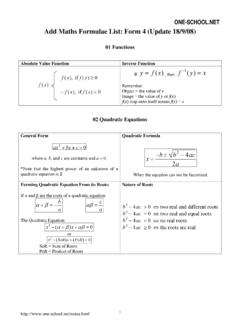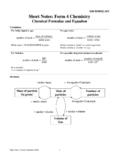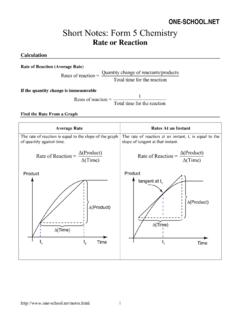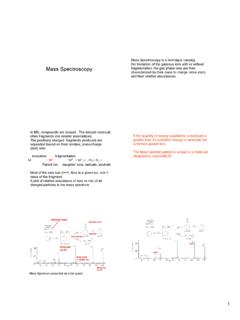Transcription of ONE-SCHOOL.NET Physics Equation List :Form 4
1 1 Physics Equation List : form 4 Introduction to Physics relative Deviation Mean DeviationRelative Deviation = 100%Mean Value Prefixes Prefixes Value Standard form Symbol Tera 1 000 000 000 000 1012 T Giga 1 000 000 000 109 G Mega 1 000 000 106 M Kilo 1 000 103 k deci 10-1 d centi
2 10-2 c milli 10-3 m micro 001 10-6 nano 000 001 10-9 n pico 000 000 001 10-12 p Units for Area and Volume 1 m = 102 cm (100 cm) 1 m2 = 104 cm2 (10,000 cm2) 1 m3 = 106 cm3 (1,000,000 cm3) 1 cm = 10-2 m (1100m) 1 cm2 = 10-4 m2 (2110, 000m) 1 cm3 = 10-6 m3 (311, 000, 000m) 2 Force and Motion Average Speed Total DistanceAverage SpeedTotal Time= Velocity svt= v = velocity (ms-1) s = displacement (m) t = time (s) Acceleration vuat = a = acceleration (ms-2) v = final velocity (ms-1) u = initial velocity (ms-1) t =time for the velocity change (s)
3 Equation of Linear Motion Linear MotionMotion with constant velocityMotion with constant accelerationMotion with changing acceleration svt=atuv+=tvus)(21+=221atuts+=asuv222+=U sing Calculus(In Additional Mathematics Syllabus) u = initial velocity (ms-1) v = final velocity (ms-1) a = acceleration (ms-2) s = displacement (m) t = time (s) 3 Ticker Tape Finding Velocity: velocitynumber of ticks 1 tick = Finding Acceleration: vuat = a = acceleration (ms-2) v = final velocity (ms-1) u = initial velocity (ms-1) t = time for the velocity change (s) Graph of Motion Gradient of a Graph The gradient 'm' of a line segment between two points and is defined as follows.
4 Change in y coordinate, Gradient, Change in x coordinate, ymxorymx = = 4 Displacement-Time Graph Velocity-Time Graph Gradient = Velocity (ms-1) Gradient = Acceleration (ms-2) Area in between the graph and x-axis = Displacement Momentum pmv= p = momentum (kg ms-1) m = mass (kg) v = velocity (ms-1) Principle of Conservation of Momentum 112 2112 2mum umvm v+=+ m1 = mass of object 1 (kg) m2 = mass of object 2 (kg) u1 = initial velocity of object 1 (ms-1) u2 = initial velocity of object 2 (ms-1) v1 = final velocity of object 1 (ms-1) v2 = final velocity of object 2 (ms-1) Newton s Law of Motion Newton s First Law In the absence of external forces, an object at rest remains at rest and an object in motion continues in motion with a constant velocity (that is, with a constant speed in a straight line).
5 5 Newton s Second Law mv muFt Fma= The rate of change of momentum of a body is directly proportional to the resultant force acting on the body and is in the same direction. F = Net Force (N or kgms-2) m = mass (kg) a = acceleration (ms-2) Implication When there is resultant force acting on an object, the object will accelerate (moving faster, moving slower or change direction). Newton s Third Law Newton's third law of motion states that for every force, there is a reaction force with the same magnitude but in the opposite direction.
6 Impulse ImpulseFt= Impulsemv mu= F = force (N) t = time (s) m = mass (kg) v = final velocity (ms-1) u = initial velocity (ms-1) Impulsive Force mv muFt = F = Force (N or kgms-2) t = time (s) m = mass (kg) v = final velocity (ms-1) u = initial velocity (ms-1) Gravitational Field Strength Fgm= g = gravitational field strength (N kg-1) F = gravitational force (N or kgms-2) m = mass (kg) Weight Wmg= W = Weight (N or kgms-2) m = mass (kg) g = gravitational field strength/gravitational acceleration (ms-2) 6 Vertical Motion If an object is release from a high position: The initial velocity, u = 0.
7 The acceleration of the object = gravitational acceleration = 10ms-2(or ms-2). The displacement of the object when it reach the ground = the height of the original position, h. If an object is launched vertically upward: The velocity at the maximum height, v = 0. The deceleration of the object = -gravitational acceleration = -10ms-2(or ms-2). The displacement of the object when it reach the ground = the height of the original position, h. Lift In Stationary Rmg= When a man standing inside an elevator, there are two forces acting on him.
8 (a) His weight which acting downward. (b) Normal reaction (R), acting in the opposite direction of weight. The reading of the balance is equal to the normal reaction. 7 Moving Upward with positive acceleration Moving downward with positive acceleration Rmgma=+ Rmgma= Moving Upward with constant velocity Moving downward with constant velocity. Rmg= Rmg= Moving Upward with negative acceleration Moving downward with negative acceleration Rmgma= Rmgma=+ 8 Smooth Pulley With 1 Load T1 = T2 Moving with uniform speed: T1 = mg Stationary: T1 = mg Accelerating: T1 mg = ma With 2 Loads Finding Acceleration: (If m2 > m1) m2g m1g = (m1+ m2)a Finding Tension.
9 (If m2 > m1) T1 = T2 T1 m1g = ma m2g T2 = ma Vector Vector Addition (Perpendicular Vector) Magnitude = 22xy+ Direction = 1||tan||yx Vector Resolution ||| |sinxp = ||| |cosyp = 9 Inclined Plane Component parallel to the plane = mgsin Component perpendicular to the plane = mgcos Forces In Equilibrium 3 Tmg= 2sinTmg = 21cosTT = 1tanTmg = 3 Tmg= 21coscosTT = 21sinsinTT mg += Work Done cosWFx = W = Work Done (J or Nm) F = Force (N or kgms-2) x = displacement (m) = angle between the force and the direction of motion (o) When the force and motion are in the same direction.
10 WFs= W = Work Done (J or Nm) F = Force (N or kgms-2) s = displacement (m) 10 Energy Kinetic Energy 212 KEmv= EK = Kinetic Energy (J) m = mass (kg) v = velocity (ms-1) Gravitational Potential Energy PEmgh= EP = Potential Energy (J) m = mass (kg) g = gravitational acceleration (ms-2) h = height (m) Elastic Potential Energy 212 PEkx= 12 PEFx= EP = Potential Energy (J) k = spring constant (N m-1) x = extension of spring (m) F = Force (N) Power and Efficiency Power WPt= EPt= P = power (W or Js-1) W = work done (J or Nm) E = energy change (J or Nm) t = time (s) Efficiency Useful EnergyEfficiency = 100%Energy Or Power OutputEfficiency = 100%Power Input Hooke s Law Fkx= F = Force (N or kgms-2)









